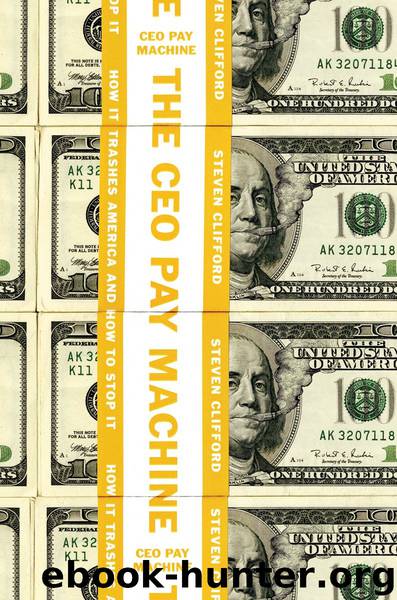The CEO Pay Machine by Steven Clifford

Author:Steven Clifford
Language: eng
Format: epub
Publisher: Penguin Publishing Group
Published: 2017-04-25T12:46:36+00:00
CHAPTER TEN
Four Boards
Gigantic CEO pay sparked shareholder protests at all four companies. At UnitedHealth Group’s annual meeting following Hemsley’s $102 million year, shareholders considered a proposal for annual advisory votes on executive compensation (“say on pay”). It came very close to passing, with 46 percent of the vote, but had little effect; Mr. Hemsley made $48.8 million the subsequent year.
At McKesson’s annual meeting in 2012, negative publicity about Hammergren’s exorbitant payday provoked shareholders to offer two resolutions, both of which were opposed by management: The first would have split the roles of CEO and chairman of the board, and the second would have allowed shareholders to act by written consent in lieu of a meeting. While they failed to pass, 38 percent of shares voted against the company’s pay plan. In 2013, McKesson shareholders said they had had enough of excessive CEO pay packages, and the proxy advisory firm ISS urged them to vote against all four members of the compensation committee for failing to fully address persistent compensation issues. Shareholders overwhelmingly rejected the board’s pay plan, with 78 percent voting against it in a nonbinding vote. They also approved an advisory measure to recapture executive compensation in cases of subsequent poor performance, the first time a clawback policy had won majority support. Attempting to mollify shareholders, Hammergren later agreed to reduce his record-setting $159 million pension benefit by $45 million. Even then, he was due a lump-sum pension of $114 million, still among the richest pensions in corporate history. In the face of this shareholder outcry, McKesson’s Pay Machine produced a $131 million compensation package for Hammergren in 2014.
Despite Cheniere’s high stock price at the end of 2013, shareholders were not happy with Souki’s compensation. They sued, arguing that shareholder votes authorizing the stock award plan had been inaccurately counted and would have failed had abstentions counted as negative votes. The suit demanded that $1.6 billion in compensation be returned to the company and forced Cheniere to delay its 2014 annual meeting from June to September.
In a “say on pay” vote at the September meeting, 88 million shares voted against the executive compensation plan; only 76 million shares supported the plan. Moreover, 53 million shares opposed the reelection of David Kilpatrick, chairman of the compensation committee, to the board. As a peace offering, Souki reduced his yearly salary from $800,000 to $1.
At Discovery’s 2014 annual meeting, shortly after Zaslav’s compensation was publicized, 41 percent of the voted shares rejected Discovery’s pay practices.
John Malone set up Discovery with two classes of stock. He owns 93 percent of the class that has ten votes per share and 0.4 percent of the class that has one vote per share. Two classes of stock and undemocratic voting are quite common in the media industry. Over four-fifths of the eighty-six largest publicly traded media companies are controlled by a single shareholder or family, including Rupert Murdoch’s News Corp. and Sumner Redstone’s Viacom.
Corporate governance experts criticize two classes of stock because they divorce economic ownership from voting control.
Download
This site does not store any files on its server. We only index and link to content provided by other sites. Please contact the content providers to delete copyright contents if any and email us, we'll remove relevant links or contents immediately.
| Anthropology | Archaeology |
| Philosophy | Politics & Government |
| Social Sciences | Sociology |
| Women's Studies |
The Secret History by Donna Tartt(18157)
The Social Justice Warrior Handbook by Lisa De Pasquale(11951)
Thirteen Reasons Why by Jay Asher(8451)
This Is How You Lose Her by Junot Diaz(6435)
Weapons of Math Destruction by Cathy O'Neil(5829)
Zero to One by Peter Thiel(5488)
Beartown by Fredrik Backman(5351)
The Myth of the Strong Leader by Archie Brown(5237)
The Fire Next Time by James Baldwin(5016)
How Democracies Die by Steven Levitsky & Daniel Ziblatt(4952)
Promise Me, Dad by Joe Biden(4908)
Stone's Rules by Roger Stone(4857)
100 Deadly Skills by Clint Emerson(4689)
A Higher Loyalty: Truth, Lies, and Leadership by James Comey(4550)
Rise and Kill First by Ronen Bergman(4545)
Secrecy World by Jake Bernstein(4388)
The David Icke Guide to the Global Conspiracy (and how to end it) by David Icke(4379)
The Farm by Tom Rob Smith(4323)
The Doomsday Machine by Daniel Ellsberg(4245)
